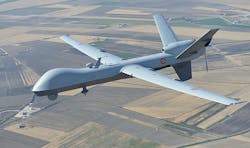Air Force asks General Atomics to upgrade MQ-9 Reaper UAVs with new data multiplexers and control
Officials of the Medium Altitude Unmanned Aerial Systems Division of the Air Force Life Cycle Management Center at Wright-Patterson Air Force Base, Ohio, announced a $14.2 million order Wednesday to the General Atomics Aeronautical Systems segment in Poway, Calif., for MQ-9 Block 5 upgrade kits.
These kits are to upgrade earlier versions of the Reaper UAV to the most modern Reaper Block 5 configuration. Upgrades consist of extended-range kits, beyond-line-of-sight kits and Barrett asymmetrical digital datalink computer (BADDC) routers.
These upgrades will enable the upgraded Reaper Block 5 unmanned aircraft to carry external fuel pods to extend their mission range; add a Ku-band beyond line-of-sight and satellite communications data link control; and the BADDC data routers.
Related: General Atomics to boost UAV firepower by integrating small-diameter bomb on MQ-9 Reaper
The BADDC routers act as payload data multiplexers to increase the amount of data that the Reaper Block 5 can send over tactical networks within the UAV's time and bandwidth limitations.
The BADDC data routers select one of several analog or digital input signals from Reaper Block 5 onboard sensors and forwards the selected input into a single line. This makes it possible for several signals to share one device or resource like an A/D converter or one communication line, instead of having one device per input signal.
The Reaper is a variation of the General Atomics MQ-1 Predator UAV that is designed for surveillance and attack missions using a suite of airborne sensors and the AGM-114 Hellfire air-to-ground missile.
Compared to the MQ-9 Reaper Block 1 models, the Reaper Block 5 has increased electrical power, secure communications, auto land, increased gross takeoff weight, weapons growth, and streamlined payload integration capabilities.
The Block 5 model has a high-capacity starter generator and upgraded electrical system with a backup generator that can support all flight-critical functions. The drone has three independent power sources to accommodate new communications such as dual ARC-210 VHF/UHF radios with wingtip antennas for simultaneous communications among multiple air-to-air and air-to-ground parties; secure data links; and an increased data transmission capacity. The Reaper Block 5 can carry heavier payloads or additional fuel.
The turboprop-powered, multi-mission Reaper armed drone can fly for more than 27 hours between refueling at speeds to 240 knots at altitudes to 50,000 feet. The medium-endurance UAV can carry payloads as heavy as 3,850 pounds, including 3,000 pounds of external stores like Hellfire missiles.
The Reaper can carry as many as four Hellfire missiles, two GBU-12 Paveway II laser-guided bombs, or two 500-pound GBU-38 Joint Direct Attack Munitions (JDAMs). Twice as fast as Predator, the Reaper carries 500 percent more payload and has nine times the horsepower, General Atomics officials say.
The Reaper has a fault-tolerant flight control system, triple-redundant avionics system, and is powered by the Honeywell TPE331-10 turboprop engine, integrated with digital electronic engine control (DEEC) to improve engine performance and fuel efficiency at low altitudes.
The Reaper can carry electro-optical and infrared (EO/IR) sensors, Lynx multi-mode radar, multi-mode maritime surveillance radar, electronic support measures (ESM), laser designators, and a variety of weapons.
The sophisticated drone has redundant flight-control surfaces; can fly remotely piloted or autonomously; has a MIL-STD-1760 stores management system; seven external payload stations; C-band line-of-sight data link control; Ku-band beyond line-of-sight and satellite communications data link control; more than 90 percent system operational availability; and can self-deploy or fly aboard C-130 utility aircraft.
This aircraft has been acquired by the U.S. Air Force, U.S. Navy, U.S. Department of Homeland Security (DHS), NASA, the United Kingdom Royal Air Force, the Italian Air Force, and soon others, company officials say. On this order General Atomics will do the work in Poway, Calif., and should be finished by February 2021.
For more information contact General Atomics Aeronautical Systems online at www.ga-asi.com, , or the Air Force Life Cycle Management Center at www.wpafb.af.mil/aflcmc.
Ready to make a purchase? Search the Military & Aerospace Electronics Buyer's Guide for companies, new products, press releases, and videos
